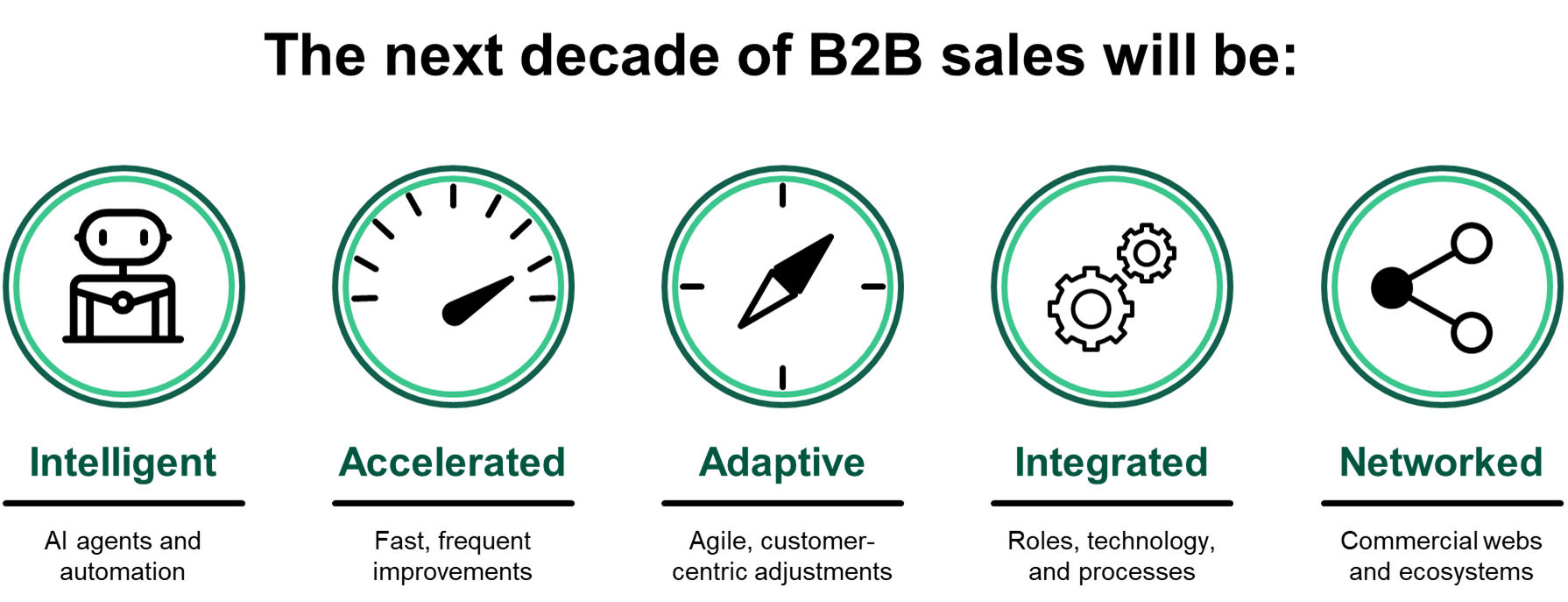With B2B Sales Disruption On The Doorstep, What’s Next?
Buying and selling continue to change, and everybody wants to know how AI affects B2B sales. Here’s the situation: Sales teams have long struggled to adapt their tools and techniques to today’s purchasing dynamic. Now, new forces stress sales organizations in unprecedented ways. Paradoxically, these same forces fuel an emerging B2B sales supercycle — an extended period of growth and transformation.
Our latest report, The Dawn Of A New B2B Sales Supercycle, looks at the future of sales. The disruptive decade ahead has characteristics never seen before, which significantly affect all revenue and go-to-market teams. Simultaneously, the future will be both chaotic and exciting. To succeed in this new reality, selling teams must unlearn much of what has made them successful in the past.
The Enduring Forces Shaping B2B Sales
Previously, the internet, cloud, and digitization have driven long cycles of growth and change. Similarly, the next supercycle is forming. This extended period of B2B sales will be more intelligent, accelerated, adaptive, integrated, and networked (see figure below). Furthermore, it will change nearly every aspect of sales: strategy, budgets, coverage, training, quotas, compensation, execution, and more. Shaping this future is a handful of forces:
- Artificial intelligence. AI bots will automate routine sales tasks, and AI agents will perform higher-order selling actions. With AI, sales process and tech will become essential.
- Self-service. Buyers continue to complete more purchasing tasks on their own. Consequently, buying motions disrupt selling motions, and sellers must prioritize buyer enablement.
- Buying complexity. Customers have more choices, tools, and stakeholders in their buying network, but this purchase complexity creates longer sales cycles and seller confusion.
- Ecosystems. Partner ecosystems are digitizing and growing, thrusting the route-to-market topic to the forefront of sales strategy. Critically, routes to market are routes to revenue.
- PE and VC composition. A greater number of opportunistic, tech-savvy private equity and venture capital portfolio companies increases competition for larger incumbents.

The Implications For Sales And Revenue Leaders
Most B2B sales organizations have an unsustainably large amount of transformation debt, a backlog of improvements that should have been made long ago but weren’t. These improvements are often shelved in favor of short-term sales goals. Unfortunately, this puts sales teams further back on the change curve. Moreover, sales leaders face shocking new realities in the next decade:
- Employment and income insecurity will rise among sales professionals. In Forrester’s Future Of Work Survey, 2024, 60% of B2B employees say they fear losing their job due to automation within the next 10 years. For B2B sellers working to hit quota, this adds to already high stress and turnover rates. Sales leaders, take note: There is an emerging wellness crisis among sellers.
- AI sales agents will be onboarded and trained to co-sell. With AI and automation driving this supercycle, 75% of B2B automation decision-makers in Forrester’s Automation Survey, 2024, indicated that they expect their organization to invest in sales automation in the next 18 months. Indeed, AI will automate selling tasks and customer touchpoints; it will also co-sell with account executives.
- Sales budgets that are heavy on headcount will be light on results. Important sales tech investments come with an expectation of cost reduction and productivity elsewhere. This creates tough trade-offs. Sales leaders must optimize budgets across a changing mix of headcount, technology, and workflow. As tech improves, headcount decisions will become agonizingly difficult for sales leaders.
- Go-to-market roles, processes, and technologies will continue to merge. Expect convergence both within sales and across sales, marketing, product, and customer success. Convergence touches everything — process, tech, roles, working groups, and more. As an example, development rep roles will likely be partially automated and combined with other go-to-market roles.
Sales Practices Must Match Sales Realities
The best sellers adapt their tools and techniques for the moment. Fortunately, that hasn’t changed much. Nonetheless, it’s difficult for long-time sales leaders to reimagine their own function — and to then get the organizational support to transform it. Yet this is exactly what sales and revenue leaders must do.
To understand how AI affects B2B sales, explore more insights in the new report, The Dawn Of A New B2B Sales Supercycle (client access required). You’ll also learn about several other trends and their implications for sales teams. Many B2B sales and revenue leaders are already adjusting to this new future. As a next step, schedule a guidance session to determine where best to start.
